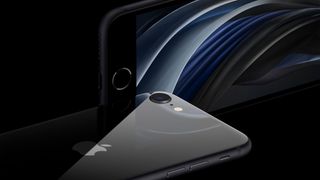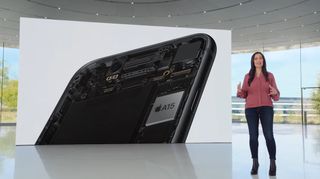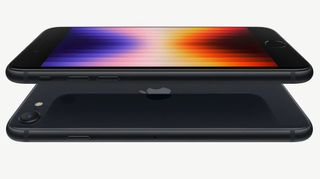
At Apple's March 8 Peek Performance event, the headliner was undoubtedly the announcement of the iPhone SE 2022. So how does Apple's latest budget smartphone stack up to its hugely popular predecessor, the iPhone SE 2020?
We’ll need to spend some quality time with the iPhone SE 2022 before we can cast any definitive judgement here, but you can tell a lot from the spec sheet alone.
While they might look similar, there are some telling differences between the new iPhone SE and its second generation predecessor. Here's how the two compare.
iPhone SE 2022 vs iPhone SE 2020: price and availability
The iPhone SE 2022 starts at $429 / £419 / AU$719 for the 64GB model. The 128GB model costs $479 / £469 / AU$799, while the 256GB model costs $579 / £569 / AU$969. Pre-orders start Friday March 11, and it'll be available in stores from March 18.
The iPhone SE 2 hit shops on April 24, 2020. The 64GB model was priced at $399 / £419 / AU$749, moving up to $449 / £469 / AU$829 for 128GB and $549 / £569 / AU$999 for 256GB.
That represents a $30 bump for the new iPhone SE over the SE 2020, though it works out to the same price in the UK and AU$30 less in Australia.

iPhone SE 2022 vs iPhone SE 2020: design
The iPhone SE 2022 essentially sticks with the exact same design as the iPhone SE 2020, which itself was based heavily on the iPhone 8. That phone, in turn, took its basic shape from the iPhone 6.
Get daily insight, inspiration and deals in your inbox
Get the hottest deals available in your inbox plus news, reviews, opinion, analysis and more from the TechRadar team.
That means a familiar chunky forehead and chin, and the same fixed Touch ID sensor-cum-home button. The second-gen iPhone SE had a 65.4% screen-to-body ratio, which is likely to be the case with the iPhone SE 3 too.
It's a shame that Apple has stuck with this 7-and-a-half year old design for yet another year, but them's the breaks. Apple's advances lie in the area of performance, not design.
Like the iPhone SE 2020, the new phone is IP67-rated, which falls short of the flagship iPhone 13 series and its IP68 rating.

That's not to say that Apple has left the new iPhone SE's design entirely alone. It's coated the phone in the same super-tough glass that covers the back of the iPhone 13 family, both to the front and the back.
There are three colors to choose from at launch: Midnight, Starlight, and Product Red – essentially the same (or similar) black, white, and red shade selection as the iPhone SE 2.
We described the iPhone SE 2020 as feeling "classy in the hand", so it seems likely the iPhone SE 2022 will feel similarly nice, despite its dated design.
At 138.4 x 67.3 x 7.3mm, the new iPhone SE is identically proportioned to its predecessor. Interestingly, though, it's 4g lighter at 144g.
iPhone SE 2022 vs iPhone SE 2020: Display
There really doesn't appear to be anything to separate these two smartphone displays. Both are 4.7-inch LCD IPS screens, with 750 x 1334 resolutions for a pixel density of 326 ppi, and a 60Hz refresh rate.
The two phones also sport an identical maximum brightness of 625 nits.
We'll need to confirm this, of course, but it's almost certain that the iPhone SE 2022's display is exactly the same its predecessor, and the iPhone 8's before that.
None of which is very impressive by modern standards, even when compared to other similarly priced phones. Take the OnePlus Nord 2, for example, with its 6.43-inch 1080 x 2400 AMOLED and 90Hz refresh rate.

iPhone SE 2022 vs iPhone SE 2020: Camera
Again, Apple hasn't gone into specifics on hardware, but it does call the iPhone SE 2022's single 12MP f/1.8 camera "an all-new camera system."
In terms of basic hardware, it looks identical to the iPhone SE 2020 camera. However, as we learned from the latter, Apple can make impressive strides forward with new processor technology and accompanying software tricks.
The new iPhone SE's camera system seems to be chiefly bolstered by the new A15 Bionic chip, which enables some of the key Neural Engine-driven camera features of the iPhone 13 range. That includes Deep Fusion, Smart HDR4, and Photographic Styles.
Apple also claims that the new SE features improved video quality, especially in low lighting conditions. Talking of which, both camera systems are capable of shooting video at 4K and 60fps.
It's a similar story around front, where both phones pack 7MP f/2.2 selfie cameras. Again, though, that A15 Bionic chip should make for superior selfies on the newer phone.

iPhone SE 2022 vs iPhone SE 2020: Specs and performance
Much of the new iPhone SE is similar to its predecessor, but there's one area where it takes a big step forward: performance.
Apple has packed its latest budget phone with the A15 Bionic processor, which is the same chip that drives the iPhone 13. By contrast, the iPhone SE 2020 runs on the A13 Bionic, which is the same chip that powers the iPhone 11.
It's a two-generational leap in performance, then. Interestingly, Apple chose to compare the iPhone SE 2022's performance with the iPhone 8 rather than the SE 2. The A15 Bionic's CPU is 1.8 times faster than iPhone 8, while its GPU is 2.2 times faster.
Helpfully, it did the same thing when the SE 2 launched, revealing that the A13 Bionic CPU is 1.4 times faster than the iPhone 8, while its GPU is 2 times faster. At a very basic level, then, the new iPhone SE is significantly faster than the iPhone SE 2020.
The new phone’s 16-core Neural Engine, meanwhile, enables activities such as live text reading within the camera app. On-device Siri and dictation are also enabled on the newer device.
Another important advance for the iPhone SE 2022 is the provision of 5G network connectivity. This brings the SE line up to the same level of connectivity as Apple's mainline iPhone 13 range.
Both phones come with 64GB, 128GB, and 256GB storage options. We would have liked to have seen the 64GB option scrapped and 128GB becoming the new default, but never mind.

iPhone SE 2022 vs iPhone SE 2020: Battery
We don’t know the battery capacity of the iPhone SE 3 just yet, but it seems unlikely to be significantly larger than the iPhone SE 2’s 1821 mAh. Still, Apple managed to boost the capacity across the iPhone 13 family despite having identical designs to their iPhone 12 predecessors, so fingers crossed.
Especially given that the iPhone SE 2’s battery life was one of its key weaknesses. Light to moderate usage was really where the that phone was at its most comfortable, and we found that it would often give up before the end of the day.
Thankfully, Apple claims the iPhone SE 3 has better battery life, courtesy of its more efficient A15 Bionic chip in combination with the “latest-generation battery chemistry and tight integration with iOS 15”. That equates to a claimed 15 hours of video playback compared to the iPhone SE 2’s 13 hours.
The small print on the iPhone SE 3 press release claims that it can gain up to 50 percent of a charge in 30 minutes using a 20W adapter (not provided). Apple claimed the same for the iPhone SE 2 using an 18W charger, so it’ll be interesting to see if the capacity of the new phone has been bumped up at all.

Takeaway
Without having put the iPhone SE 3 through its paces, we can only draw limited conclusions. However, initial impressions point to an affordable iPhone that really hasn’t evolved all that much from its two-year-old predecessor.
Its design is nigh-on identical, if a little tougher, while its display is similarly unchanged. The camera system appears to be much the same, but we have experienced Apple’s impressive SoC-based improvements first hand with the iPhone SE 2.
Talking of SoCs, the iPhone SE 3 utilised the iPhone 13’s A15 Bionic chip, which is significantly faster than the iPhone SE 2’s A13 Bionic. That’s the big improvement here.
It’s a slightly disappointing evolution at first glance, but we’ll have to go hands-on to confirm whether Apple has made sufficient progress with its affordable smartphone line.
Most Popular
